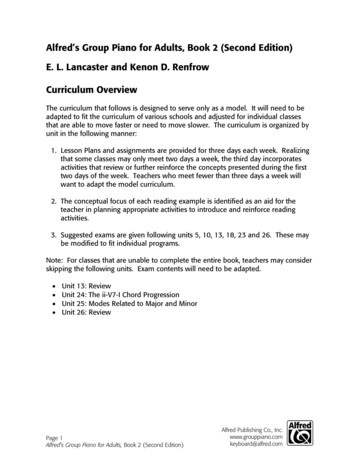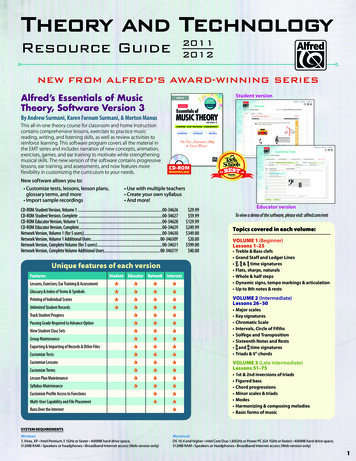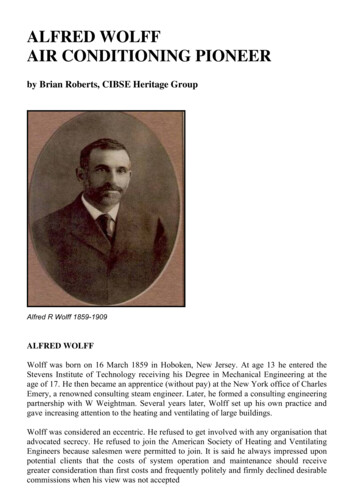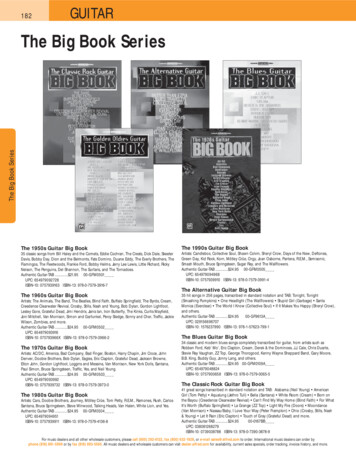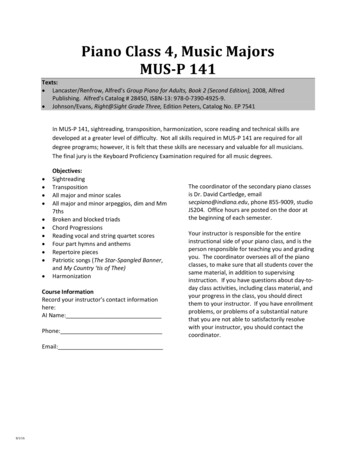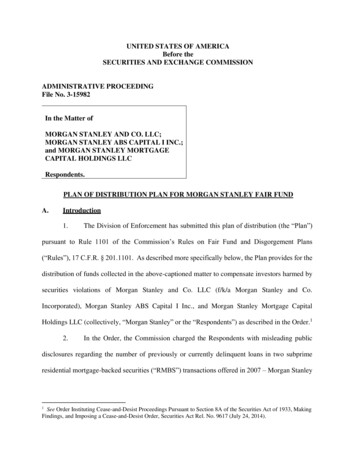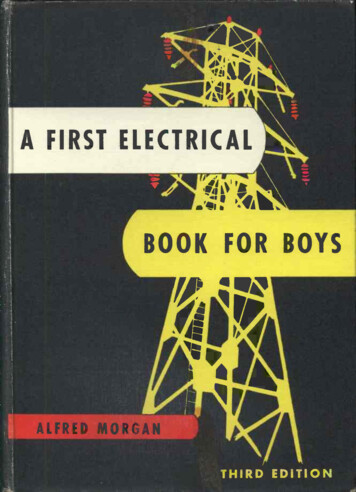
Transcription
Books by Alfred MorganTHINGS A BOY CAN DO WITH ELECTRICITYTHE BOYS' BOOK OF ENGINES, MOTORS AND TURBINESAQUARIUM BOOK FOR BOYS AND GIRLSA PET BOOK FOR BOYS AND GIRLSFIRST CHEMISTRY BOOK FOR BOYS AND GIRLSTHE BOYS' FIRST BOOK OF RADIO AND ELECTRONICSTHE BOYS' SECOND BOOK OF RADIO AND ELECTRONICSTHE BOYS' THIRD BOOK OF RADIO AND ELECTRONICSADVENTURES IN ELECTROCHEMISTRY
A FIRSTELECTRICAL BOOKFOR BOYSbyALFRED MORGANIllustrated by the authorCHARLES SCRIBNER'S SONSNEW YORK
THIRD EDITION COPYRIGHT 1963 ALFRED MORGANCOPYRIGHT 1935, 1951 CHARLES SCRIBNER'S SONS;RENEWAL COPYRIGHT 1963 ALFRED MORGANThis book published simultaneously in theUnited States of America and in CanadaCopyright under the Berne ConventionAll rights reserved. No part of this bookmay be reproduced in any form without thepermission of Charles Scribner's Sons.B -3.64[V]PRINTED IN THE UNITED STATES OF AMERICALIBRARY OF CONGRESS CATALOG CARD NUMBER 63-17039Many of the illustrations in this book were drawn from photographs and illustrations furnished by: The American Tele-phone and Telegraph Co., The Western Union TelegraphCo., The Consolidated Gas Co., of New York, The GeneralElectric Co., The Warren Telechron Co., The Western Electric Co., The National Carbon Company, The Chicago, Burlington and Quincy Railroad Co., The Electric-Auto-lite Company, Motorola Semiconductor Products Division, Inc., andChrysler Corporation. The American Telephone and Telegraph Co. supplied modern telephone equipment to be takenapart for information and sketching.Much valuable information and many useful facts werealso furnished. The author is indebted for this assistance.
CONTENTSCHAPTER ONEWHAT IS ELECTRICITY AND WHERE DOES IT COME FROM?PAGEICHAPTER TWOABOUT MAGNETISM24CHAPTER THREEABOUT BATTERIES40CHAPTER FOURHOW ELECTRICITY PRODUCES54CHAPTER FIVETHE ELECTRIC TELEGRAPH, THE FIRST COMMERCIAL USE FORELECTRIC CURRENT67CHAPTER SIXELECTRIC BELLS, WIRES, AND SOMETHING ABOUTELECTRICAL MEASUREMENTS87CHAPTER SEVENHOW HEAT IS PRODUCED BY ELECTRICITY ANDELECTRICITY IS MADE TO OBEY104CHAPTER EIGHTHOW ELECTRICITY TRANSMITS SPEECHV116
viCONTENTSCHAPTER NINEPAGE136ELECTRIC LIGHTCHAPTER TENHow ELECTRICITY IS GENERATED AND THE ELECTRICMOTOR DOES ITS WORK158CHAPTER ELEVENINDUCTION, ONE OF ELECTRICITY'S MOST USEFUL TRICKS173CHAPTER TWELVEHow ELECTRICAL POWER IS MADE AND DISTRIBUTED182CHAPTER THIRTEENTHE ELECTRICAL SYSTEM OF AN AUTOMOBILE191CHAPTER FOURTEENSENDING MESSAGES THROUGH SPACE210CHAPTER FIFTEENRADIO, TELEVISION, RADAR AND ELECTRONICS219CHAPTER SIXTEENELECTROCHEMISTRY, A KIT OF TOOLS FOR THE CHEMIST258CHAPTER SEVENTEENMISCELLANEOUS USES OF ELECTRICITY265INDEX275
A FIRST ELECTRICAL BOOK FOR BOYS
CHAPTER ONEWHAT IS ELECTRICITY AND WHERE DOES ITCOME FROM?ONE of the first questions which any boy who is interested in electricity and the things which electricity does will want to have answered is:WHAT IS ELECTRICITY?Strange to say, you will not be able to find the answer here or inany other book. Neither will anyone, even a famous scientist or engineer, be able to give you a satisfactory answer to your question.They can only make a guess and tell you what electricity may be because no one knows what electricity really is.Electricity is the name of something which no one has ever seenand whose nature is a mystery. You may ask, but don't we feel electricity when we get a shock and don't we see it when it flashes sometimes? And the answer is no. We never see or feel or hear electricityitself. We only see and feel and hear the things which electricitydoes. We can see the light from an incandescent lamp, hear thewords spoken into a telephone many miles away, and feel the heatfrom an electric iron, but at no time has electricity shown itself tous. Even when an electric spark snaps with a flash before our eyes,we are not seeing or hearing electricity. We are only seeing a flashand hearing a sound which electricity produces.In spite of the fact that so little is known about the real nature ofelectricity, this mysterious power is so useful that it is often calledthe servant of mankind. But this was not always so. Although you
2A FIRST ELECTRICAL BOOKand I are accustomed to incandescent electric lamps, electric elevators, radios, telephones, and many other electrical marvels whichhelp to make us more comfortable and which it would seem hard toget along without, there are people alive today who are old enoughto remember the time when, with the exception of the electric telegraph, these other wonderful electrical things did not exist.For a long time in the world's history electricity was only a plaything-just something to do scientific tricks with. That was becausemen had not yet found out enough about it to use it properly. It ishardly one hundred years ago that electricity was first put to workwhen something useful was found for it to do and it ceased being entirely a plaything. No one knew much about the rules or laws whichelectricity always obeys before that time and so they did not knowhow to build machines for using electricity. All of the really accurateelectrical knowledge of those old days could easily have been put intoa book smaller than this one. Now it requires hundreds of volumes,enough to fill a very large room. The things which have been foundout about electricity have become a beautiful science and the manydifferent uses which have been developed for its powers are so widespread that every man, woman, and child has their way of living affected by it and has been made more comfortable in some way orother.WHERE DOES ELECTRICITY COME FROM?No one knows where electricity comes from any more than theyknow what it is. We only know that it hides almost everywhere andthat there are several ways of bringing it forth from its hiding places.Scientists speak of producing and generating electricity but thesewords are a little misleading if they give you the idea that electricitycan actually be created or manufactured. For that is not so. The
WHAT IS ELECTRICITY?3whole world seems to be a great reservoir of electricity and by "producing" or "generating" we only mean a method of gathering someof this great inexhaustible supply together so it can be used.Electricity can be brought forth from its hiding places in strangeand unsuspected ways. Chemicalsand magnets may be used and socan friction. The first electricitywhich anyone knew anything aboutwas gathered together by means offriction. Whenever most substancesare rubbed together, the frictionbetween them brings forth electricity. Some materials reveal electricity when they are torn or broken(rapart. The actual amount of electricity which appears in this manner may be very small and difficultBENJAMIN FRANKLINfor anyone not equipped with theProved that lightning is electricity.right sort of scientific instrumentsto perceive but it is nevertheless there. Even doing such a simplething as sharpening a pencil with a knife produces electricity. Thereare instruments which are so delicate and sensitive that they willmeasure the electricity generated on the wooden shavings as theyare torn off the pencil by the knife blade.WHO WOULD THINK OF LOOKING FOR ELECTRICITYIN A LUMP OF SUGAR?But it can be found there if you know how. If you take a drylump of sugar into a pitch-dark room and after waiting a few mo-
XROLL OFTAPELUMP OFSUGARDRY SHEETOF PAPER11)BITS OF. BITS OFCHARCOALPAPERCAN COVEREXPERIMENTS WITH STATIC ELECTRICITYIf you break a dry lump of sugar in the dark, there will be a faint flash of light in the sugar. When astrip of tire tape is suddenly pulled off its roll, there is a faint violet -colored light where the tape is tornaway. Rubbing a sheet of dry paper will generate static electricity. A fountain pen or pipe stem whichhas been rubbed will attract small bits of paper or charcoal.
WHAT IS ELECTRICITY?Sments until your eyes are accustomed to the darkness, break the lumpin half between your fingers, there will be a quick flash of faint lightin the sugar. Here is the explanation. When the little crystals ofsugar are torn apart, electricity comes forth and it is this electricitywhich creates the faint light whichis seen.When a strip of tire tape-or electrician's tape-is suddenly pulled offits roll, there is a faint violet -coloredlight at the place where the tape istorn away. You can easily see it in adark room. This light is also createdby electricity. The electricity is produced when the sticky substance onthe tape is torn apart.Who would have thought that alump of sugar or a roll of tire tapeELECTRICITY IN STRANGEcould be used to produce electricity?PLACESa cat will generate electricity whenThere are a great many other things Evenyourub its fur with your hands.besides sugar and tire tape which willdo it. You may include a pair of slippers, a cat and a sheet of writingpaper in the strange list if you care to. Have you ever slid your feetalong over a thick carpet on a cold winter's night, when it was dryand clear outdoors, and then quickly touched your finger to theradiator or to the knuckles of an unsuspecting friend? 1 Were yousurprised when the snapping little spark jumped from your fingertips. The flash of that little spark released the electricity with whichyour body had become charged by your slippers rubbing on thecarpet. Leather belts rubbing against their pulleys often produce1 Rubber soles will not work for this experiment. Thin-soled leather slippers on your feetgive the best results.
A FIRST ELECTRICAL BOOK6so much electricity that precautions are taken to prevent it in factories where an electric spark might cause an explosion.In winter, when you are combing your hair with a hard rubbercomb, sometimes your hair will stand up all over your head insteadof lying down flat and if you listen carefully, a faint crackling noisewill be heard. Electricity is showing itself again in an unsuspectedway. It has been brought forth by the friction between your hairand the comb.Even a cat will generate electricity when you rub its fur withyour hands. When the weather is cold and dry if you are in a darkroom, you will be able to see, in fact hear and feel, the sparks madeby the electricity generated when you rub a cat. If you touch thecat's nose with one hand while you are stroking his fur with theother, a tiny spark will jump from your finger. It won't hurt thecat-it will only ruffle his dignity. After you have tried the experiment once, don't tease him any longer.A sheet of paper which has been warmed before the fire and thenlaid on a bare wooden table and briskly rubbed with your hand willcling to the table when you try to lift it up by one corner. It is elec-tricity, generated on the paper by rubbing with your hand, whichcauses the paper to cling to the table.ELECTRICITY MAY BE A NUISANCE AT TIMESIn paper manufacturing and printing, a great deal of trouble isoften caused by the electricity generated on the paper by friction asit passes through the machines. The sheets of paper cling and drag.Keeping the air damp in the pressroom is one of the means used inovercoming this.When gasoline is poured from one tank into another, electricityis sometimes produced and explosions and fires have occurred which
WHAT IS ELECTRICITY?7were due to this cause. The next time that you see a gasoline truck,notice the chain which hangs down and drags along the ground.The chain connects the tank with the earth and prevents electricityfrom being generated in sufficient quantity, when the gasoline isdrawn off, to cause an explosion.THERE IS MORE THAN ONE KIND OF ELECTRICITYElectricity which is generated when two substances are rubbedtogether is called frictional electricity. It is also called static electricity from a Greek word meaning "standing," because it is generally at rest and stands still on the surface of things. Static electricityis not of much use. The electricity used for lighting our homes, foroperating motors, telephones, etc., is not produced by friction and isnot static electricity. It is not like static electricity because it doesnot stand still. It is produced by magnetism and moves in a currentlike a stream of water running through a pipe. This useful sort ofelectricity is called dynamic and current electricity. It is more important than static electricity because it is more useful. So is the electricity which is generated by batteries and called galvanic and sometimes voltaic electricity after Galvani and Volta, the two famousmen who discovered how to produce it. Much more will be toldabout these other forms of electricity later in this book when we arethrough talking about static electricity.WHAT IS STATIC ELECTRICITY GOOD FOR?There is almost no practical use for static electricity except toteach young scientists and future engineers many facts which areuseful to know. Thirty-five years ago, however, when doctors firstcommenced to use the newly discovered X-ray for examining brokenbones or searching for bullets and pieces of metal which had become
8A FIRST ELECTRICAL BOOKlodged in the human body, machines which generated static electricity were often used to operate the X-ray tubes. There is a muchmore satisfactory way of producing current for X-ray tubes in usetoday. Instruments called transformers are used. There will be moresaid about them later.WHAT ARE THUNDER AND LIGHTNING?For a long time the whole world wanted to know the answer tothat question. We know now. It is static electricity which jumpsbetween the clouds and the earth or between the clouds themselvesand produces the flashes and crashing thunder. The snap and flashof an electric spark are miniature thunder and lightning. The terrifying flash and crash in the heavens were once thought to be suchsilly things as warfare among the gods and all sorts of other strangeimaginary happenings until Benjamin Franklin proved that light-ning is really a gigantic spark produced by electricity leapingthrough the atmosphere and that thunder is the noise which thehuge spark causes.The question that is now running through your mind is no doubt:WHERE DOES THE ELECTRICITY WHICH CAUSESLIGHTNING COME FROM?But unfortunately just like the answers to many other questionsin the realm of science, the explanation is not wholly satisfactorybecause no one knows the whole answer. Scientists have satisfiedthemselves as to this fact however. The air is usually electrified,even in clear weather. The cause of this is not thoroughly understood. The sun's rays may be responsible. In fact all electricity maycome from the sun. Electricity in the atmosphere collects on watervapor in the air. Little particles of water vapor, joining together to
WHAT IS ELECTRICITY?9form larger -sized drops, help the electricity to accumulate and formcharges powerful enough to crash across the heavens in a great boltof lightning.Scientists have tried to keep accurate records of electrical stormsover large areas of the world's surface and estimate from the factsgathered in this manner that there are approximately 44,000 thun-der -and -lightning storms every year and about 6,000 lightningflashes taking place in the earth's atmosphere every minute. So youELECTRICITY FROM THE CLOUDS STRIKING A POWER LINEThe unseen electric current in the power line goes about its work silently and invisiblybecause men have learned how to control it. There is much less energy in the crashing andflashing lightning but it is uncontrolled and so often makes havoc.1111 1.mmommom.mompo.111111. MN/ft EI.g,
toA FIRST ELECTRICAL BOOKsee there is a lot of thunder and lightning in the world all the timeeven though there may not be a storm going on where you are.IS LIGHTNING USEFUL?There is probably nothing in this world of ours which does nothave its purpose-even lightning. Those alarming bolts of electricity which dart from the sky and often shatter trees and buildingsand sometimes kill men and animals, have been found to have auseful result. They release chemicals called nitrogen compounds inthe air. These nitrogen compounds are a very fine fertilizer. It isestimated that nearly 100,000,000 tons find their way into the soilevery year and help make the plants grow. But lightning is not theonly way Nature has of displaying electricity's strange behavior tous. We sometimes see what is known as theAURORA BOREALISThe Aurora Borealis, also called Northern Lights, which hangsout its beautiful drapery in the skies of northern latitudes, is somesort of an atmospheric electrical effect whose real cause is not known.Those who live in the southern part of the United States have prob-ably never seen it. The weird spectacle sometimes appears in theskies in the latitude of New York. It occurs more often and is morebrilliant farther north. It often happens at a time when the mariner's compass and long-distance telegraph lines are distributed bywhat is known as a magnetic storm. There is a coincidence betweenthese mysterious events with changes which take place in the spotson the sun. We know a lot about this old world upon which welive but we don't know everything, and sun spots, aurora, and magnetic storms are some of the things which are not understood.
I2A FIRST ELECTRICAL BOOKAs if these strange happenings were not enough, atmosphericelectricity has still another little trick calledSAINT ELMO'S FIRESailors are often very much startled to see a flickering luminouslight at the tips of a ship's masts and spars at night. It was noticedfor thousands of years without anyone knowing what it was untilabout one hundred and fifty years ago. It is called Saint Elmo's Firebut is really static electricity passing from the earth and throughthe ship into the atmosphere. As it escapes from the ends of themasts and spars a flickering light is produced. Saint Elmo's Firediffers from lightning because the electricity leaks away graduallyinstead of disappearing in a fraction of a second in one crash.THE FIRST ELECTRICAL EXPERIMENTEROur knowledge of the beginnings of certain sciences is very limited and meager. This is especially true in the case of the sciencecalled electricity. No one knows how long ago static electricity wasfirst noticed or who the first person to experiment with it was. Ofcourse there has always been lightning flashing around overheadbut no one knew that it was electricity until about the year 1745.Although he might not have been actually the first experimenter,the first man to write about electricity, as far as we know, was Thales.This ancient scientist was born about the middle of the seventhcentury B.C. and might have been either a Greek or a Phoenician.No one knows which-neither do we know what he looked like. Helived in Greece and spent a great deal of time in Egypt. Judgingfrom the things which the famous Greek philosopher Aristotleclaims that Thales did twenty-five hundred years ago, he was one ofthe few men in those days who could reason for more than a few
WHAT IS ELECTRICITY?13minutes without becoming very much muddled. Thales was a care-ful observer and an exact thinker-a real scientist at a time whenscientists were few and far between. He did many brilliant thingswhich make people still read and write about him almost three thousand years later, but in an electrical book for boys we are only interested in one of them. He drew attention to the curious power of aresin, called amber, to attract and pick up light bodies after it hadbeen rubbed and he gave the reason for its strange behavior. Amberis the gum from an extinct species of trees which once grew alongthe shores of the Baltic Sea and which after lying in the ground forthousands of years, became hard and petrified. A great many museums have pieces of amber on exhibition which contain the bodiesof insects imprisoned in the resin when it was soft thousands of yearsago. The Greeks called amber elektron and used it for making prettyyellow beads for necklaces. It is from this Greek word for amber thatelectricity gained its name. We still make necklaces of amber-alsopipe stems and cigarette holders.Although a great many other substances will also generate staticelectricity and attract light obj ects when rubbed, it is a curious factthat amber and jet were the only two which it was known wouldact in this strange manner until the time of the famous QueenElizabeth whom you read about in English history. Men had beenplaying with amber and jet for hundreds of years but none of themhad ever thought to rub anything else and see what it would do untila Doctor Gilbert, who lived in Colchester, England, in the sixteenthcentury, discovered that a long list of other substances, such as glass,diamond, sulfur, sapphire, sealing wax, rock crystals, and resin,which he called electrics, would also behave like amber and jetwhen rubbed.In these days of radios and X-rays when so much is known aboutelectricity, Doctor Gilbert's discovery that there were other sub-
14A FIRST ELECTRICAL BOOKstances besides amber which would produce electricity, may appearto you to have been unimportant. But three hundred years ago itstartled the whole scientific world and the consequence was thatelectricity drew more attention than it ever had before. Menstarted to rub all sorts of things with silk and wool to see whatwould happen. When enough different people start to think aboutthe same thing it is bound to bring results.Experiments which only a learned scientist could perform in theseventeenth century can be tried in the twentieth century by any boywho is interested in electricity. Things which were mysterious yesterday are often simple today because they are better understood.A great deal of fun can be had experimenting with static electricitywithout the necessity of spending a penny for apparatus.This you should know. It will help to make your experimentsmore successful. Static electricity is a nervous, flighty thing. It ishere for a moment and then gone in a j iffy. It is easy to produce buthard to keep. Much of this difficulty is due to moisture in the air.There is more moisture in the air during the summer time thanduring the winter. For that reason experiments with static electricity are difficult to perform in the summer. They work best inthe winter.AN EXPERIMENT MORE THANTWENTY-FIVE HUNDRED YEARS OLDYou will not need a piece of amber to try the same sort of anexperiment which Thales did more than twenty-five hundred yearsago. There are a number of common things right at hand whichwill produce static electricity when rubbed. Instead of amber, youcan use a glass rod, a stick of sealing wax, a hard rubber pipe stem orcomb, or some article made of a plastic such as Lucite.
WHAT IS ELECTRICITY?15Any of these things will become charged with electricity or electrified if you rub them briskly with a piece of warm dry flannel orwoolen cloth. A piece of rabbit's fur will work even better thanflannel. You will not have to shoot a rabbit to get a piece of rabbit'sfur. It is used a great deal for lining coats and you can get a pieceat a furrier's.Snip some tissue paperinto very small bits,about as large as the headof a dressmaker's pin.:D*11 ftmliGmEsFountain PenThen hold a hard rubberpipe stem or a glassrod which has just beenrubbed briskly with apiece of flannel or furover the bits of paper.Pipe StemBring it down slowlyand just before it quitetouches them, some ofthe pieces of paper willjump up to meet the rod.If you watch very closelyyou may see some of thelittle pieces of paper flyRubber Combquickly away from therod after they havetouched it. There is agood reason for this. Be-fore the bits of paperGlass Rod.touched the rod, theyWILL PRODUCE STATIC ELECTRICITYA number of common objects will produce static electricitywhen rubbed. A glass rod, a hard rubber or Lucite comb, awere attracted by themay be used in your experiments.hard rubber pipe stem or a fountain pen made of plastic
6A FIRST ELECTRICAL BOOKelectricity on the rod. They themselves had no electrical chargeall the electricity was on the rod. They were neutral, as it is called.But when they came into contact with the rod, some of the electricity on the glass spread itself over the surface of the paper bits.The paper became covered with electricity or charged, as it is called.From this experiment it may be seen that there is no attraction be-tween two substances when they are both charged, but that quitethe contrary, they repel each other. When Thales performed thisexperiment he used a piece of amber instead of a glass rod of course,and instead of paper, little pieces of straw or lint.ONE OF THE LAWS OF ELECTRICITYNo matter how many times you try this little experiment whichhas just been described, the same thing will always happen. Someof the little pieces of paper will first jump up to touch the rod andthen fly off again. This is because electricity always obeys certainrules or laws, as they are called. Since there are a great manydefinite rules which govern the behavior of electricity and it alwaysobeys them, it is what scientists call an exact science. One of thelaws of electricity was discovered by means of the experiment whichwe have just been talking about. It is that when two objects becomecharged with the same kind of electricity they are no longer attracted to each other. In fact, they are repelled or pushed away.That is why some of the bits of paper fly away from the rod. Theybecome charged with the same kind of electricity.It was the discovery of definite facts like this about electricitywhich eventually made it possible to build all sorts of electrical instruments and machinery. Not this one particular law or fact, ofcourse, but a whole mass of them. By learning a lot of facts aboutelectricity, you will be able to understand it better.
WHAT IS ELECTRICITY?17You may be able to observe the workings of this important lawof electricity and at the same time perform an interesting experiment, if, instead of bits of paper, you use some very small pieces ofcharcoal. A burnt match broken into small fragments will supplythe charcoal. Put the pieces of charcoal on a piece of metal. Thetop of a baking powder or coffee can will do very nicely. Hold theelectrified glass rod over them. They will jump up to meet therod but as soon as they touch it, they will fly off again more quicklythan the pieces of paper did. The pieces of charcoal have no chargebefore they touch the rod; they are neutral. Once they touch therod, however, they are charged or electrified-with the same kindof electricity which appeared on the rod when you rubbed it, andso are no longer attracted but are pushed away.Before you can understand how electricity will sometimes behaveand why certain electrical devices are made as they are, it is necessary to know something aboutCONDUCTORS AND INSULATORSA list of all the vast number of electrical devices which have beendeveloped during the past one hundred years would include thousands of contrivances varying in size from the little bulb for a pocketflashlight to a giant locomotive. Copper, brass, iron, steel, nickel,platinum, tungsten, glass, porcelain, paper, rubber, silk, cotton, andmany other materials, each one carefully chosen for a particular reason are used in the manufacture of these things. Glass is used for onepart and copper for another because electricity behaves differentlywhen it comes into contact with these two different substances. Ithappens that glass is an insulator of electricity and copper is a conductor. There is a great deal of difference in the ability of differentsubstances to conduct or insulate and that decides which material is
A FIRST ELECTRICAL BOOK18the best to use for a particular purpose when building electricaldevices.One of the reasons why you can produce electricity quite easilyby rubbing sealing wax, hard rubber, glass, resin, and rock crystalis because they do not carry or conduct it away when it is generated.)(If a piece of iron or copper is rubbed, the electricity passes intothe hand of the person holding the metal and down into the earthas fast as it is produced because metals are conductors of electricity.Glass and rubber are non-conductors or insulators. Some substancesare neither good conductors nor good insulators and they are usuallycalled partial conductors. Here is a list of various substances arranged so as to come under their proper UCTORSOR INSULATORSSilverCottonGlassCopperDry woodSilkIronAll other metalsLiquid acidsMarbleResinStoneQuartzPaperOilsLiquid alkalisDamp airWoolChemical salts insolutionImpure waterEarthShellacHard rubberWaxMicaDry airPorcelainAny substance which is wet is a conductor.After you have looked over these lists it should be easy for you tounderstand why electricity is usually led from place to place oncopper wires mounted on glass knobs or insulators and why wiresare usually covered with rubber. The glass and porcelain knobs andthe rubber covering on wires help to prevent the electricity fromleaking away.If you do not have much luck experimenting with static elec-
WHAT IS ELECTRICITY?19tricity in the summer time, you will now understand why. Remember that it is due to moisture in the air. Damp air is a partial conductor and conducts the electricity away as fast as you can produceit.Now that you understand something about insulators and conductors, you will also know that when you have generated electricityby rubbing a glass rod or a fountain pen you should not lay it downor permit it to touch anything if you do not want it to lose itscharge. The amount of electricity which you are playing with isvery small-infinitesimal is the best word to describe it.HOW STATIC ELECTRICITY MAY BE DETECTEDSome of the scientists who were experimenting with electricityone hundred and fifty years ago devised very sensitive instrumentsfor detecting weak charges of static electricity. They called themelectroscopes. There are several
books by alfred morgan things a boy can do with electricity the boys' book of engines, motors and turbines aquarium book for boys and girls a pet book for boys and girls first chemistry book for boys and girls the boys' first book of radio and electronics the boys' second book of radio and
